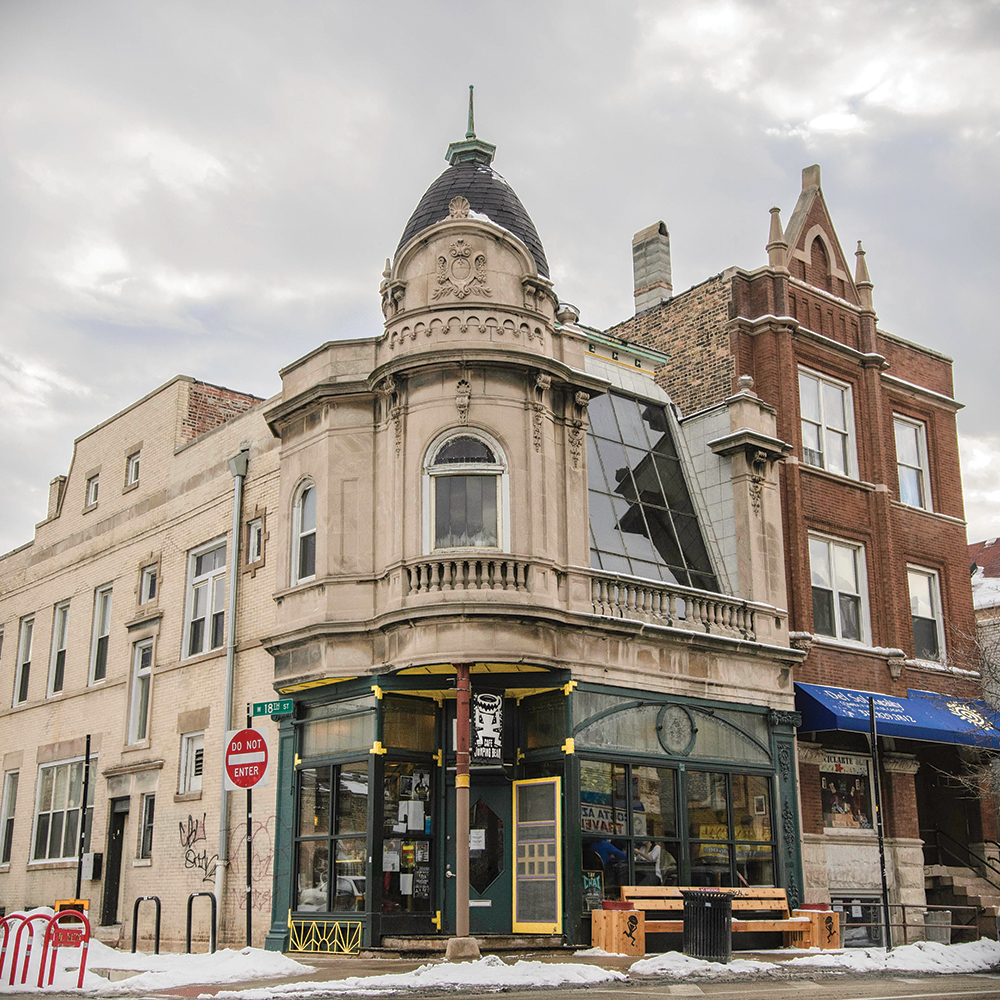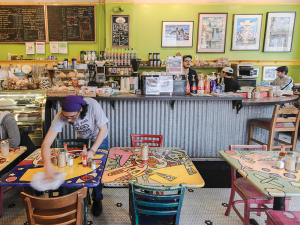
It’s Saturday morning at Cafe Jumping Bean, on 18th Street in Pilsen. A middle-aged man in a wool sweater reads from a book called “La Posibilidad de Cambio,” (“The Possibility of Change”) – as he slurps down a bowl of bean soup. Two college-aged girls catch up over focaccia sandwiches and lattes. A crime and homicide photographer from a major Chicago newspaper checks for news updates on his iPhone. Luis Montenegro-Ferrel, a painter who has been a Cafe Jumping Bean regular since it opened twenty years ago, is looking for an empty seat. Although it’s a mere twelve degrees outside and the streets of Pilsen are painted white with snow, all ten tables in the modestly-sized lime green and Caribbean blue room are occupied.
When long-time Pilsen resident Eleazar Delgado decided to open Cafe Jumping Bean in the location of an old barber shop, he hoped to provide the neighborhood with one thing it was lacking: good coffee. “There was a need for it in this community,” says Delgado, who was twenty-six when he opened the cafe. “There was nothing south of Division Street back when I opened this place. Nothing in this neighborhood that was rich in the arts.”
Instead of serving sopes, tacos, and tamales, like many of his neighbors, Delgado made mochas and chais, sandwiches and salads with optional sides of jalapeno, avocado, and salsa. Delgado was inspired by the coffee shops that he visited on a trip to Monterrey, Mexico. “In Mexico, they’ve got a very community feel. It’s a very relaxed atmosphere. They’re cozy, they’re small, and they have simple menus.”
“In the nineties there was really no other such place for artists to meet outside schools,” says Montenegro-Ferrel, a tall thin man with high cheekbones and a soft, melodic voice, who works out of an art studio in the neighborhood. “When Eleazar opened the restaurant, all of the artists felt that we needed to support it, a new place where we could meet. Business picked up immediately.”
Montenegro-Ferrel arrived from Durango to Pilsen with his parents, food-industry workers, in 1975, and he’s been a Cafe Jumping Bean regular for nearly twenty years. At the time of the opening, Montenegro-Ferrel, then an art student at Columbia College, would play Spanish guitar in the evening to help Delgado bring in new customers. “Eleazar said, ‘Luis, why don’t you come in here?’ In order to pay for my books, I would play here or in the subways. I did it for a couple of winters and one or two summers. But eventually, I think they got tired of my repertoire.”
Since 2000, Pilsen has lost over a quarter of its Latino residents. According to Montenegro-Ferrel, the Cafe has always attracted a diverse group of artists, journalists, and students, as well as businessmen from the Loop and tourists looking for an “authentic” Pilsen experience.
Delgado says that demographic shifts in the neighborhood have changed the cafe’s clientele. “It’s no longer a primarily Latino neighborhood. It’s mixed. The businesses on the strip are also very diverse. It’s nice. It brings in different people. The neighborhood is more touristy than before because we have the largest Latino museum in the country…and we’ve seen UIC double in size.”

In recent years, Delgado has turned off the Internet on weekdays between 11:30 and 2:30, and all day on weekends. “We are a small cafe. We seat a total of thirty people. Back in 2007, when the crazy Wi-Fi thing started, it was a really big change for the cafe,” says Delgado. “Before everyone came in and talked, played a game of chess, read a book. But my lunchtime people were coming in, and couldn’t find a place to sit. That year I happened to go on a trip to Seattle, where I discovered the ‘Wi-Fi schedule.’ People thought I was nuts. They said, ‘You know, listen, you’re going to kill your business.’ We gave it a shot and it actually increased my business.”
“It’s not that he’s trying to be mean,” says Abel Uribe, a friend of Delgado and Montenegro-Ferrel. “There’s just such a high volume of people here. You see, we’ve been here almost an hour and it’s been packed the entire time.” Short, with a ponytail and beret, Uribe is a local photojournalist from Jalisco, Mexico. For the past ten years he has used Cafe Jumping Bean as a base for the crime reporting he conducts around the city. “Cafe Jumping Bean is just a friendly place for anybody who’s after a good cup of coffee,” Uribe says.
“I go once a week,” says Yana Kunichoff, another journalist, who writes for the Chicago Reporter. “You can see all the different shades of Pilsen here. I think Jumping Bean is on the border of what people call East and West Pilsen. It’s this space that has managed not to completely become bars and restaurants.”“To me it’s just this humble business run by a humble owner,” says Montenegro-Ferrel. “You look at the history of coffee shops, even coffee shops in Europe, they are always a place where a lot of great energy came from, and certainly the people, not just one person, have shaped that.”

